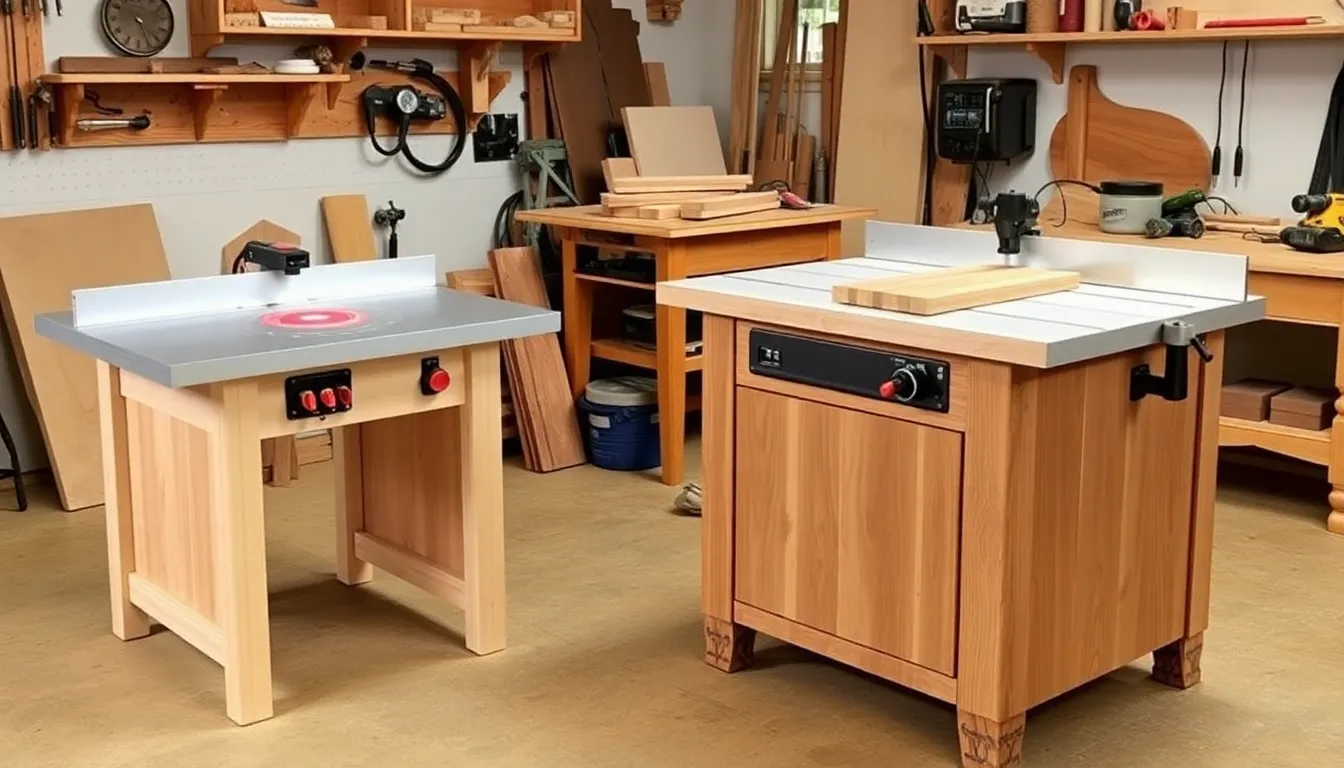In the world of woodworking, a router table is like the superhero sidekick every craftsman needs. It takes the often chaotic art of routing and transforms it into a smooth, precise operation. Imagine having a trusty partner that helps create flawless edges and intricate designs while you sip your coffee and admire your latest creation. Sounds good, right?
Table of Contents
ToggleOverview of Router Tables
Router tables serve as valuable tools in woodworking, providing stability and precision in routing tasks. An individual can achieve clean cuts and detailed designs with ease. Many woodworkers rely on these tables to simplify the routing process, transforming complex tasks into manageable ones.
Router tables consist of a flat, stable surface with a router mounted underneath. This configuration allows for enhanced control when guiding the wood across the bit. The user can adjust the height of the router bit, facilitating varied cut depths.
Various types of router tables exist, catering to different needs. For example, portable router tables offer flexibility for mobile projects, while larger models provide more workspace for intricate designs. Additional features like adjustable fences and miter slots contribute to their versatility.
Safety remains a priority when using router tables. Many come equipped with features like dust collection systems to minimize debris. Proper use of push blocks and feather boards further enhances safety, allowing for steady, controlled movements.
Finishing techniques flourish with the use of router tables, enabling woodworkers to create unique edge profiles. Craftsmen can easily switch bits to achieve desired shapes, such as roundovers or chamfers. With the right setup, a router table can elevate both the quality and efficiency of woodworking projects.
Investing in a high-quality router table pays off. It can lead to improvements in craftsmanship and workflow. Many enthusiasts find that the precision and versatility offered by router tables elevate their woodworking experience significantly.
Types of Router Tables

Router tables come in various types, each catering to specific needs in woodworking. Understanding these types helps woodworkers choose the best option for their projects.
Benchtop Router Tables
Benchtop router tables offer portability and convenience, making them suitable for small workshops or mobile projects. They typically have a compact design, allowing for easy storage. Most models feature adjustable fences, which enhance accuracy during routing tasks. Woodworkers find these tables ideal for basic routing needs and smaller pieces of wood. Commonly, users appreciate their affordability and ease of use, making them accessible for hobbyists. Built-in safety features often include dust ports and protective covers, promoting a secure working environment.
Cabinet Router Tables
Cabinet router tables provide stability and a robust workspace for more complex woodworking projects. These tables come with a larger surface area, accommodating bigger workpieces effectively. Many cabinet models include built-in storage for bits and accessories, keeping the workspace organized. With superior construction, these tables offer minimal vibration during routing, resulting in cleaner cuts. Woodworkers enjoy the ability to integrate advanced features like router lifts, which simplify height adjustments. Often, cabinet router tables are preferred by professionals seeking precision and durability in their equipment.
Key Features to Consider
Considering router tables involves understanding critical features that directly affect performance and user experience. Three key areas to focus on include size and stability, fence systems, and motor power.
Size and Stability
Size impacts both workspace and project capability. A larger table provides ample room for handling big projects, while a compact design suits smaller workshops. Stability is crucial to ensure clean, precise cuts. Heavy-duty materials often enhance durability and lessen vibrations during operation. Users find that a stable router table fosters a more controlled routing process, resulting in better craftsmanship.
Fence Systems
Fence systems contribute significantly to routing accuracy. Adjustable fences allow for precise measurements and easy repositioning as required. Many models feature micro-adjustments which enhance fine-tuning for intricate designs. A well-designed fence system also provides support for larger workpieces, preventing movement during routing. Craftsmen appreciate the ease of using such systems to achieve repeatable results and consistent edges.
Motor Power
Motor power directly influences cutting efficiency and versatility. A robust motor handles various bit sizes and woodworking tasks. Options typically range from 1.5 to 3 horsepower, ensuring compatibility with different materials. Craftsmen recognize that higher horsepower facilitates smoother operation for demanding cuts. Choosing a powerful motor also suggests potential for greater productivity in complex projects.
Benefits of Using a Router Table
Router tables enhance stability and precision during woodworking tasks. Users experience improved control when guiding workpieces across the bit. Adjusting the router bit height enables varied cut depths, which adds versatility to the projects.
A key advantage lies in the ability to create intricate edge profiles effortlessly. By swapping bits, woodworkers customize shapes that elevate the design of their pieces. Many router tables also feature adjustable fences, further supporting accurate routing.
Efficiency increases significantly with the use of a router table. Clean cuts reduce the need for extensive sanding or finishing work. Woodworkers can complete complex designs faster, leading to improved productivity overall.
Safety features grant peace of mind during operation. Many tables include dust collection systems that maintain a clean workspace. Users often benefit from utilizing push blocks and feather boards to maintain control for safer cutting processes.
The versatility of router tables accommodates various woodworking styles. Whether working on portable projects or larger pieces, different table types meet specific needs. Benchtop models suit smaller spaces, while cabinet tables support larger workbooth and complex designs.
Ultimately, investing in a quality router table improves craftsmanship. Enhanced workflow facilitates a more enjoyable woodworking experience. As capabilities expand, woodworkers find themselves creating with greater precision and creativity.
Popular Router Table Models
Several router table models stand out for their performance and features. The Bosch RA1171 offers a spacious tabletop and an adjustable fence, making it suitable for both beginners and professionals. Users appreciate its sturdy construction and smooth surface for various routing tasks.
The Kreg PRS1045 is another popular choice, known for its precision and versatility. Many woodworkers favor its adjustable heights and compatibility with various router models. This router table excels in creating intricate designs thanks to its solid build and easy-to-use features.
With the Grizzly G0623X, professionals often find a comprehensive solution for larger projects. The table includes a powerful motor and a wide base, providing excellent stability during routing. Users value its ability to handle heavy workpieces without compromising precision.
A growing preference exists for the Bench Dog ProTop router table among hobbyists. Its compact design allows for easy storage, yet it maintains a stable surface for accurate cuts. Many appreciate the inclusion of dust collection systems for a cleaner workspace.
The Triton TRA001 stands out because it doubles as both a router and a router table. This dual functionality appeals to woodworkers looking to save space. Its advanced features, such as the micro-adjustable height, enhance accuracy.
Craftsmen also frequently choose the Incra I-Box for its innovative fence system. This model enables precise adjustments for different workpieces, ensuring accurate cuts every time. Users often cite its miter slot setup as a significant advantage for complex designs.
Overall, these popular router table models provide a range of options, catering to various woodworking needs and preferences. Each model brings distinct features that enhance both the efficiency and quality of woodworking projects.
A router table is an invaluable addition to any woodworker’s toolkit. Its ability to provide stability and precision transforms the routing process into a more controlled and enjoyable experience. With various models available, woodworkers can find the perfect fit for their needs, whether they require portability or a robust workspace for intricate designs.
Investing in a high-quality router table not only enhances craftsmanship but also streamlines workflow, allowing for creative expression through unique edge profiles and clean cuts. As woodworkers explore the capabilities of these tools, they’ll discover that a router table is essential for elevating their projects to new heights.


